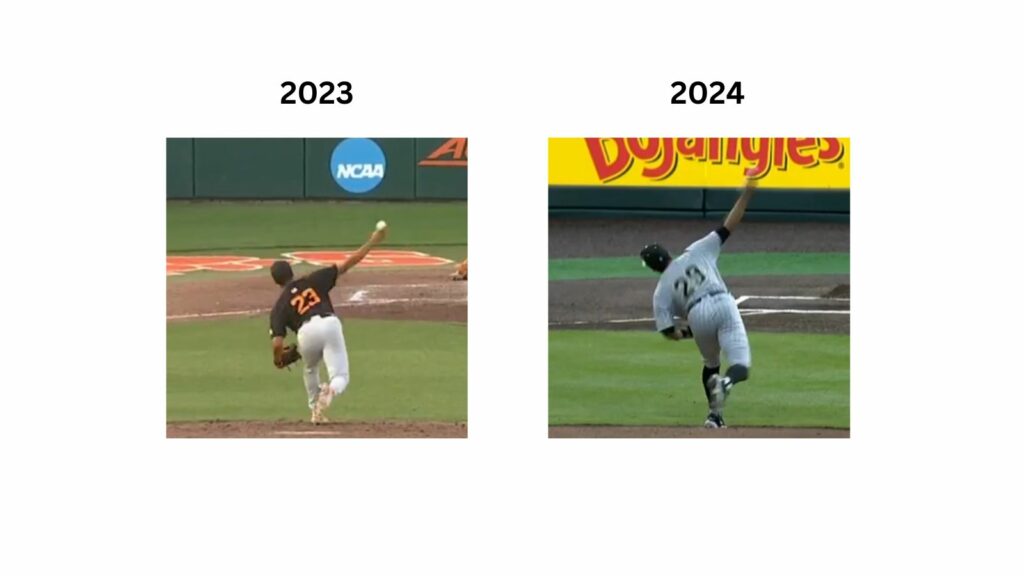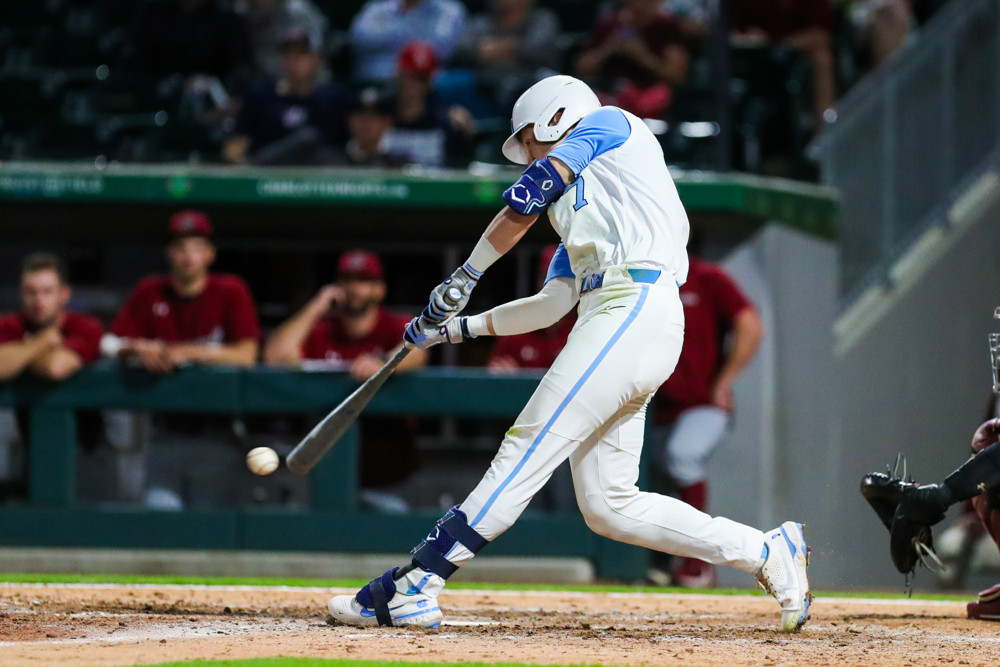You can find all our MLB Draft scouting reports here.
Photo: Bryan Lynn/Icon SportsWire
| Skill | Grade |
| Fastball | 65 |
| Slider | 70 |
| Curveball | 55 |
| Changeup | 55 |
| Control | 50 |
| Future Value | 60 |
Name: Chase Burns
College: Wake Forest University
Bio: R/R 6-3, 210 lbs.
DOB: 01/16/2003
Written by Brandon Tew
Analysis:
Chase Burns is an electrifying pitching talent who exudes emotion and energy on the mound coupled with gaudy stuff that puts him in a classification of must-watch. He’s a big presence on the mound, throwing hard fastballs touching 100 mph and a slider that elicits whiffs at a high clip.
College Career:
Chase Burns started his collegiate career at the University of Tennessee where he shined at times during his freshman and sophomore years. However; an up-and-down end to his time in Knoxville and a move to the bullpen caused him to hit the transfer portal.
Burns decided upon Wake Forest as his next destination. Their famous pitching lab was a lure in hopes of stepping up his game during his junior season. He did not disappoint, posting one of the best pitching seasons in the country. The ACC Pitcher of the Year posted great numbers throughout the season and during the beginning of his campaign looked nearly unhittable at times.
| Year | ERA | IP | K% | BB% | K-BB% |
| 2022 | 2.91 | 80.1 | 31.2 | 7.6 | 23.6 |
| 2023 | 4.25 | 72.0 | 38.4 | 7.4 | 31 |
| 2024 | 2.70 | 100.0 | 48.8 | 7.7 | 41.1 |
Yes you read that right. Burns led the country with a 48.8% strikeout rate this season striking out 191 hitters in 100 innings. This put him a fraction ahead of the other top arm in this draft class, Hagen Smith, who had a 48.6% strikeout rate.
Burns makes batters look foolish at the plate. He had three pitches in the 90th percentile in terms of Whiff% this season. His slider is a hellacious pitch that he can manipulate the shape on. He pairs that with a downer curveball that he can bury in the dirt. His four-seam fastball has exceptional ride and high velocity, which makes it a menacing pitch to face.
Pitching Mechanics:
Multiple Camera Angles: The Foundation of Accurate Analysis
A single camera angle can be misleading, often leading to incorrect assumptions about an athlete’s mechanics. To conduct a thorough analysis, multiple angles are essential:
Side View: Provides insight into linear… pic.twitter.com/IYlaVZ84RL
— Rob Blanc (@coachblanc) July 3, 2024
Burns starts his windup with his body slightly turned at an angle towards the third base dugout with his back foot more turned and his front foot at a 45-degree angle and his glove in front of his belt. His initial move is a tiny step toward first and minuscule toe taps with his rubber foot for rhythm.
Burns then goes into his leg lift with an aggressive drift forward for momentum. His left knee stops at peak height around his chest with his foot turned slightly toward second base, creating a closed front side in a stacked position.
As he enters the hinge phase he drops his body, shifting his weight and breaking his hands as his arm glides down to behind his right knee. He then rides down the mound with his leg kicking out, staying in that stacked position. He delays the rotation of his hips until a few moments before the foot strike, while also creating a stretch by keeping his chest back and getting upright.
He has an extreme trunk tilt to create a high arm slot, but he does a great job of not leaking energy to get to that position. Of note, his arm slot was a little higher this season for Wake Forest because of his more upright posture and more tilt in his delivery.

At foot strike his arm is on time and at a 90-degree angle. As he comes into his lead leg block he drives energy through his leg up his body as he whips his arm through.
It’s a LOT of hip-shoulder separation creating a lot of energy into ball release. To finish the delivery his right leg swings through – even at times straightening out – as he recoils his arm with an athletic finish.
You can tell by the way Burns moves on the mound that he is an explosive athlete who gets into outlier positions, which translates into explosive stuff. He will lift his back foot off the ground before ball release. Sometimes it affects his command of pitches if he overextends his back leg too much and loses timing in his body.
Chase Burns, Mechanics (Side view) pic.twitter.com/EBCM2PQv1C
— Rob Friedman (@PitchingNinja) March 17, 2024
Arsenal:
Fastball:
Burns fastball is a hard cut-ride pitch with minimal arm-side movement. He is a supinator who throws from a high slot and gets the ball to explode through the top of the zone. The pitch is thrown hard with an average velocity of 98 mph but he has touched 102 mph, with multiple 101s and 100s this season from him.
The biggest wart for Burns is the amount of slug he allows on the pitch.
Against left-handed hitters it can get crushed. His opponents slugging percentage was much higher versus lefties than righties. Burns’ four-seam works best up in the zone where he can take advantage of the riding action and slight cut. For lefties, Burns’ fastball might be seen well by hitters out of his hand because of the high arm slot.
Burns is also super aggressive with his locations. Wake Forest would have the catcher sit ‘middle’ often and he would throw the pitch in the middle of the zone a lot. His command of the fastball is something to improve in pro ball. The pitch is still terrific in shape and velocity, and improved command with better locations should help minimize hard contact.
Slider:
Burns’ slider is the whiff monster that you don’t want to see behind your closet door. The pitch is nightmare fuel for batters and makes all kinds of hitters look silly at the plate. It has a plus shape, but what stands out the most is Burns’ manipulation of it.
Against left-handed hitters, he can throw more of a pure gyro slider below the zone. Pitch tracking will blend both the curve and slider but most of the season Wake Forest would use traditional signs for Burns. When the catcher put down three fingers, the slider could get as low as 85 mph with depth and as high as 92 mph and more horizontal.
He appears to be blending shapes with what he possibly threw at Tennesee to what works best against left-handed hitters spinning the ball below the barrel and into the dirt for chase.
Here’s a sampling of some sliders he threw to both lefties and righties:
Chase Burns, Wicked Cutter. ✂️ pic.twitter.com/hD9xP6zuUd
— Rob Friedman (@PitchingNinja) March 5, 2022
The fact he can throw a pitch with more sweep to right-handed hitters while getting more on top and ripping down on the ball to throw a more vertical gyro pitch to lefties makes it a demolisher against both handedness.
Curveball:
Burns’ curveball is a legitimate hammer of a breaking ball, living in the 80-84 mph range. The pitch is a nice change of pace from the rest of his arsenal but he can throw the pitch harder when he wants. He will throw it for an occasional strike stealer but for the most part, he’s trying to bury the pitch on top of the plate.
Chase Burns, Unfair 5 Pitch K Sequence.
100mph, 100mph, 101mph, 100mph & 83mph Hammer. 😳
Imagine facing this after studying for Calculus. pic.twitter.com/ixjQsfMpIx
— Rob Friedman (@PitchingNinja) March 22, 2024
When Burns is pumping fastballs by you, the curve – working out of the same tunnel – is hard to lay off. He will throw the pitch to both right- and left-handed hitters but since the slider is so nasty, the curveball just plays off of it as a different shape. But it’s really more of a different spin and velocity look.
Chase Burns got bored throwing 99-101 with a 92 mph slider against the first 5 batters he saw. So he decided to whip out a mid-80s hammer to end the 6th AB. 5 Ks already.
Good god. pic.twitter.com/7gSQtvBSjA
— Joe Doyle (@JoeDoyleMiLB) February 17, 2024
When Burns gets into pro ball he could play with the shape of the curveball but in its present form it will be a nice above-average pitch to throw as a wrinkle. He gets some gnarly swings at it.
Changeup:
Burns possesses an above-average changeup that he throws sparingly. The pitch has a decent separation from his fastball velocity-wise, sitting around 90 mph. He doesn’t make the pitch fade into the lower part of the zone and below it for swings.
Chase Burns, 93mph Changeup. pic.twitter.com/XbgBPLVKOq
— Rob Friedman (@PitchingNinja) March 16, 2024
Instead, he zones the pitch, and it will just stay firm in the zone. It Induces weak contact over whiffs. Playing around with a different changeup, even experimenting with a splitter out of his high slot like Trey Yesavage, might be worth trying out. But there’s enough currently as a fourth pitch to manufacture good results. He has some feel for it.
Energy and Demeanor:
When talking about Burns you can’t leave out the raw emotion he exhibits on the mound throughout a game. Pitching with pent-up energy and competitiveness, Burns will let you know when he’s excited about a pitch or big strikeout.
Chase Burns energy rules so much pic.twitter.com/4ZSwz31Jr4
— Stephen Schoch (@bigdonkey47) May 11, 2024
Chase Burns 🔥 energy > pic.twitter.com/yiUgGTyTHR
— Francisco Lindo (@frankiepaulino_) June 13, 2023
Burns shows so much emotion on the mound to where you can’t take your eyes off of him. He’s simply a lightning rod of energy each time he pitches.
Projection:
Chase Burns is an electrifying righty with traits and tools that teams want. He’s nowhere near a finished product but he has frontline rotation stuff. Couple that with extreme competitiveness and you have yourself a potential all-star.
Burns has an excellent feel for spin while using his athleticism on the mound to obliterate the zone with high-velocity pitches. If he can get his command to a decent level he will be a true force on the mound for whatever team drafts him.
MLB Comp: Dylan Cease

